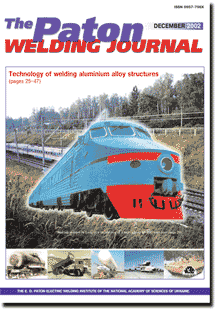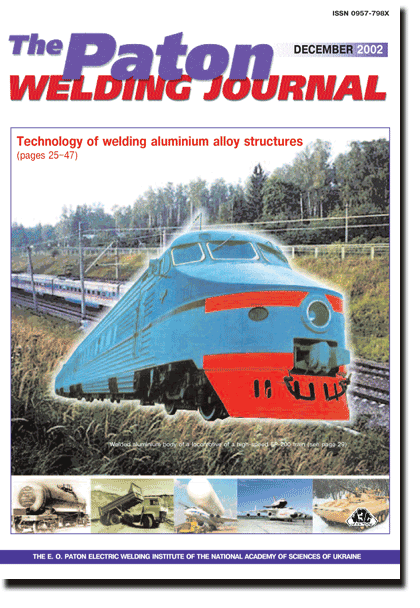

(You are viewing the simplified file contents)
AS = «Automatic Welding» - 6 issues per year;
TPWJ = «PATON WELDING JOURNAL» - 12 issues per year;
SEM = «Electrometallurgy Today» - 4 issues per year;
TDNK = «Technical Diagnostics and Non-Destructive Testing» - 4 issues per year.


| SCIENTIFIC AND TECHNICAL | |
| Paton B.E., Bulatsev A.R., Gavrish S.S., Zagrebelny A.A., Pavlova S.V. and Shulym V.F. Welding technologies under extreme conditions. Part 2. Degree of risk and possibilities for risk mitigation. | 2 |
| Results of basic tests conducted to verify and establish safety of the "Universal" hardware in performing welding operations under the open space conditions and the possibilities of reducing the degree of risk are considered. | |
| Markashova L.I., Dobrushin L.D. and Arsenyuk V.V. Improvement of weldability of high-strength aluminium alloys in explosion cladding. | 12 |
| Peculiarities of plastic deformation and process of hardening in the zone of the joints on commercially pure aluminium AD1 and annealed aluminium alloy 1201AM, explosion welded to high-strength aluminium alloy of the 1201AT type, are considered. To increase the safety factor for ductility of the deformed layers and improve weldability in cladding high-strength aluminium by the explosion welding method, it is recommended to soften the mating surfaces by preliminarily chemically cleaning them from hardening phases. | |
| Korotynsky A.E., Makhlin N.M. and Bogdanovsky V.A. About design of electronic controllers of welding current for multistation welding systems. | 16 |
| It is shown that the main drawback of multistation systems based on ballast rheostats, consisting in increased energy consumption, can be prevented in their replacement by electronic controllers of welding current made on power transistor switches of the third and fourth generations. These schemes are based on welding current coverters using pulse-width modulators with wide functional capabilities of welding-technological properties. | |
| 40th ANNIVERSARY OF THE PWI DEPARTAMENT FOR PHYSICAL-METALLURGICAL PROCESSES OF WELDING LIGHT METALS AND ALLOYS | |
| Ishchenko A.Ya. Investigation and development of the technology of light alloy welding at the PWI. | 25 |
| Dovbishchenko I.V. and Steblovsky B.A. Development of methods for arc welding of aluminium and its alloys. | 27 |
| History of development and upgrading of methods and technologies for arc welding of aluminium and its alloys by the Department for Physical-Metallurgical Processes of Welding Light Metals and Alloys at the E.O. Paton Electric Welding Institute is described. The role of the Institute in mastering the technologies for welding specific parts is noted. | |
| Voropaj N.M. Distribution of rate and pressure of plasma flows in welding arcs. | 31 |
| Radial and axial distribution of gas-dynamic characteristics of plasma flows in welding arcs has been studied. Arc column shape was approximated in the form of a truncated cone of a height, equal to arc length, and radii of upper and lower bases determined as corresponding sizes of a luminous region on the arc filming frames. Comparison of calculated data with available experimental data showed a satisfactory correlation of results obtained for the rate and pressure of plasma flows in definite welding arcs. | |
| Ishchenko A.Ya., Dovbishchenko I.V., Mashin V.S. and Pashulya M.P. Features of consumable-electrode arc welding of aluminium alloys in neon and its mixtures with helium and argon. | 35 |
| Volt-ampere characteristics of the steady and impulse arc in mixtures of different inert gases and features of weld formation and geometry are analyzed. A fundamental possibility and cost-effectiveness of application of helium-neon mixtures for protection of the welding zone is demonstrated. | |
| Poklyatsky A.G., Lozovskaya A.V. and Grinyuk A.A. Prevention of formation of oxide films in welds on Li-containing aluminium alloys. | 39 |
Effect of different technological factors on formation of extended filamentary inclusions of oxide films in TIG welds on Li-containing aluminium alloys is considered. It is suggested that these defects are caused primarily by a higher melting temperature of filler metal, compared with base metal. Recommendations allowing production of quality welded joints on Li-containing aluminium alloys are given. | |
| Skorina N.V. and Mashin V.S. Coated electrodes of UANA grade for welding and surfacing aluminium and its alloys. | 43 |
| The paper gives the characteristics and some features of the technology of manufacturing coated electrodes for manual arc welding of aluminium and its alloys, developed at the PWI. The need is shown for completion of chemical reactions, proceeding in preparation of the coating mass to stabilize it during extrusion. The optimal temperature of electrode baking is established, which provides a low susceptibility of coatings to absorption of atmospheric moisture. | |
| Voropaj N.M. and Mishenkov V.A. Combined method for plasma and arc welding using different-polarity current pulses (Hidra-process). | 46 |
| The process of combined plasma and arc welding of aluminium alloys 10-30 mm thick was developed. The process provides for feeding pulses of current (reverse polarity) to the first and third tungsten electrodes as welding progresses, and, in the intervals between them, pulses of current (straight polarity) to the central plasmatron. Design of the device for realisation of the process and its technological capabilities are given. | |
| BRIEF INFORMATION | |
| Tararychkin I.A. Method of determination of corrective actions in statistical control of welding processes. | 48 |
| Procedure of a simultaneous construction of charts of control of condition and relative accuracy for defining corrective actions directed to the recovery of a disturbed accuracy of the technological process is offered. Procedure capabilities are shown on example of making a circumferential weld using technology of narrow-gap arc welding. | |
| Khorunov V.F., Sabadash O.M., Maksimova S.V. and Stefaniv B.V. Dispersion-strengthened heat-resistant solder. | 50 |
| Methods for production, properties and microstructure of dispersion-strengthened solder Sn-39Pb were studied. Short-time strength of soldered joints made by using the dispersion-strengthened solder, depending upon the content of the strengthening phase, was evaluated. | |
| Index of articles for TPWJ'2002, No. 1-12. | 53 |
| List of authors. | 59 |
(You are viewing the simplified file contents)
The cost of subscription/purchase order journals or individual articles
| Journal/Currency | Annual Set | 1 issue printed |
1 issue |
one article |
| AS/UAH | 1800 UAH | 300 UAH | 300 UAH | 150 UAH |
| AS/USD | 192 $ | 32 $ | 26 $ | 16 $ |
| AS/EUR | 180 € | 30 € | 25 € | 15 € |
| TPWJ/UAH | 7200 UAH | 600 UAH | 600 UAH | 280 UAH |
| TPWJ/USD | 384 $ | 32 $ | 26 $ | 16 $ |
| TPWJ/EUR | 360 € | 30 € | 25 € | 15 € |
| SEM/UAH | 1200 UAH | 300 UAH | 300 UAH | 150 UAH |
| SEM/USD | 128 $ | 32 $ | 26 $ | 16 $ |
| SEM/EUR | 120 € | 30 € | 25 € | 15 € |
| TDNK/UAH | 1200 UAH | 300 UAH | 300 UAH | 150 UAH |
| TDNK/USD | 128 $ | 32 $ | 26 $ | 16 $ |
| TDNK/EUR | 120 € | 30 € | 25 € | 15 € |
AS = «Automatic Welding» - 6 issues per year;
TPWJ = «PATON WELDING JOURNAL» - 12 issues per year;
SEM = «Electrometallurgy Today» - 4 issues per year;
TDNK = «Technical Diagnostics and Non-Destructive Testing» - 4 issues per year.

